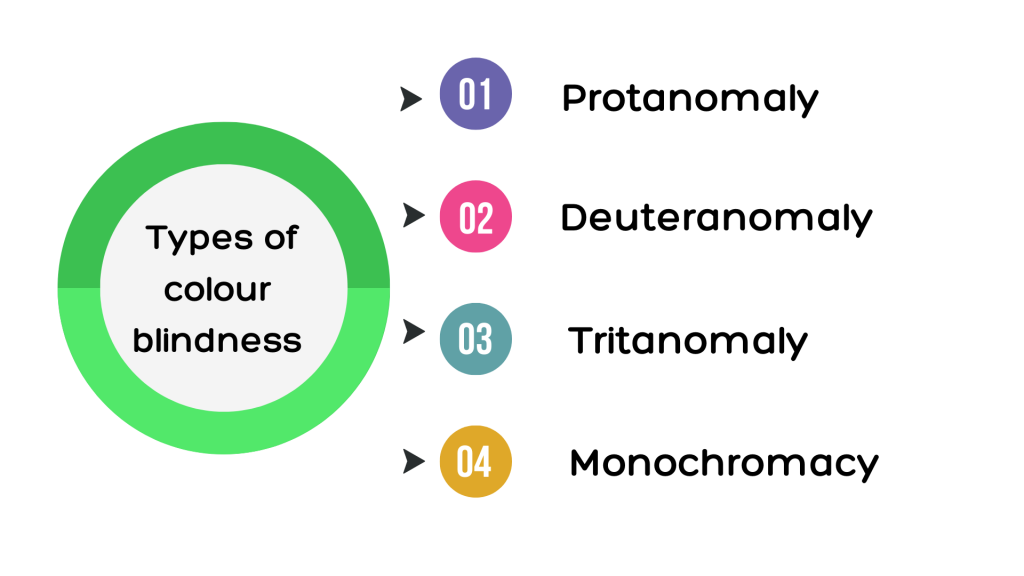Colours play a significant role in our daily lives, influencing how we interpret the world. Think about what life would be like if there weren’t any beautiful colours in the world. Colour vision deficiencies (CVD) affect millions worldwide; therefore, this is a genuine problem for them. This article will dig into the fascinating topic of colour blindness, discussing its different forms, underlying causes, and diagnostic procedures. Understanding Colour Blindness.
What is Colour blindness & causes: It is a visual impairment that affects a person’s ability to perceive certain colours accurately. The condition arises due to a deficiency in the specialized cells of the retina called cones. These cones are responsible for detecting different wavelengths of light and transmitting the information to the brain, allowing us to see a broad spectrum of colours.
Types of colour blindness

Protanomaly: Individuals with this type have difficulty perceiving red light, making them see a shifted spectrum towards green.
Deuteranomaly: People with deuteranomaly have trouble detecting green light, causing a shift towards the red end of the spectrum.
Tritanomaly: This is a rare colour blindness that affects blue-yellow perception due to defective blue cones.
Monochromacy: In sporadic cases, individuals may have only one functioning cone, causing them to see the world in black, white, and shades of grey.
Diagnosing Colour Vision Deficiency
Testing for colour blindness is crucial if you or someone you know may have the condition. Colour vision deficits can be identified by a battery of tests, including:
- Ishihara Colour Test: This is by far the most commonly used screening test for colour blindness. It consists of plates containing dots of different colours and sizes arranged in specific patterns. People with normal colour vision can see numbers or shapes embedded in the plates, while those with a colour vision deficiency may struggle to recognize them.
- Farnsworth D-15 Test: This test evaluates colour discrimination by having participants arrange 15 colour discs in the correct order. Those with colour vision deficiency tend to arrange the discs differently from those with normal colour vision.
- Lanthony D-15 Test: Similar to the Farnsworth D-15 test, this method involves arranging colours in a specific order. However, the colours used in this test are more suitable for detecting mild colour vision deficiencies.
- Cambridge Colour Test: This computer-based test assesses the entire colour spectrum, including blue-yellow and red-green deficiencies. It provides a detailed analysis of the type and severity of colour blindness.
- Anomaloscope: The anomaloscope is a sophisticated instrument to diagnose and quantify red-green colour deficiencies. The patient matches a mixture of two colours by adjusting the intensity of each component.
Living with Colour Blindness

Discovering that you have colour blindness may initially be disheartening, but it’s essential to remember that people with CVD can lead fulfilling lives with some adaptations. For instance, many rely on label colour codes, pattern recognition, and context clues to distinguish colours effectively. Additionally, advancements in assistive technology have made it easier for those with colour blindness to access tools and applications that aid in colour identification. We have also blog on eye care emergencies.
Ten handy tips for living with colour blindness
- Awareness and acceptance: Understanding your colour blindness and accepting it as a part of who you are can be the first step towards adapting to life with this condition.
- Use colour-blind-friendly tools: Nowadays, various colour-blind-friendly tools are available, such as apps that help identify colours, browser extensions that adjust colour schemes, and colour-filtering glasses that enhance colour perception.
- Label clothing: When organizing your wardrobe, use labels or tags on clothing items to identify their colours. You can also rely on patterns and textures to distinguish between garments.
- Differentiate objects based on brightness and contrast: Pay attention to brightness and contrast rather than colour alone. This can help you differentiate objects and navigate your surroundings more effectively.
- Learn colour positions: In contexts where colour coding is essential, like traffic signals, memorize the positions of the colours. For instance, the top light is typically red, the middle is yellow, and the bottom is green.
- Use alternative indicators: Instead of relying solely on colour-coded information, look for supporting cues, such as labels, symbols, or text, to identify items or understand charts and maps.
- Choose colour-blind-friendly designs: If you are designing presentations, graphs, or materials for others, opt for colour schemes that are accessible for colourblind individuals. Tools like Colour Universal Design (CUD) can assist with this.
- Seek career options compatible with colour blindness: Some professions, such as graphic design or electrical wiring, might be challenging for colourblind individuals. However, many other careers are colour-blind-friendly, so consider exploring various options that match your interests and strengths.
- Regular eye check-ups: Ensure you have regular eye check-ups to monitor your condition and discuss any changes or concerns with your eye care professional.
- Share experiences with others: Joining online or local communities of people with colour blindness can be beneficial. Here, you can exchange experiences, tips, and advice with others facing similar challenges.
Blog Summary
Colour blindness is a unique disease that changes how people see the world around them. Understanding the different kinds of colour blindness and how they affect people is essential for fostering understanding and acceptance. If you think you or someone you know might be colourblind, you might want to take one of the above tests to find out for sure. Remember that a person’s ability or potential is not limited by being colourblind; with the right help, they can enjoy the world’s beauty in their own way.

